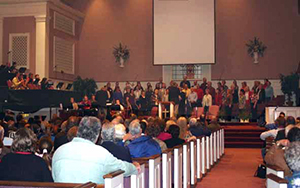Ten years ago, the Nelson Baptist Association was “unhealthy and unhelpful,” as pastor Matthew Spandler-Davison puts it. The central Kentucky association’s 40 churches could only muster 50-60 messengers for annual meetings, and it was a strain to populate the body’s 15 committees.
But a group of local pastors began meeting, praying and dreaming about a more vibrant form of local cooperation. A decade later, 600-700 people attend the Nelson Association’s annual meetings and the average church’s yearly giving to the association has increased by nearly $1,000.
So what happened?
“We just threw everything out and said, we’re going to almost start over, re-launch this association,” said Spandler-Davison, pastor of Redeemer Fellowship Church in Bardstown, Ky. “Let’s get rid of all the committees, all the leadership structure – everything’s up for grabs. … Let’s instead just evaluate who our churches are, who wants to associate with each other and why they want to associate.”
An intensive study of the association’s structure and the needs of its churches led in 2009 to the adoption of new bylaws, a new vision statement and a new structure consisting of three teams focused on ministries where churches saw the greatest need for local cooperation.
|
Nelson Baptist Association photo A revitalization of central Kentucky’s Nelson Baptist Association increased annual meeting attendance from about 60 to nearly 700, as pictured here. |
The church evangelism team focuses on helping churches partner to share the Gospel and plant churches locally, across North America and internationally. The church equipping team focuses on building healthy churches through training and consultation. The church and community ministries team focuses on meeting needs locally through a crisis pregnancy center, a biblical counseling ministry and homeless ministries.
In addition to forming ministry teams, the association streamlined its administrative ministries.
“We said, we can do those things far better together as an association of 42 churches [now 45] than we ever could do individually,” Spandler-Davison said. “… There was very little opposition because no one looked back and said, ‘This old structure is worth fighting for.’”
Stan Lowery, the director of missions who led the Nelson association through its transition, said one problem under the old structure was that about 100 people took turns serving in a host of associational positions that were not meeting churches’ needs. A lack of enthusiasm among churches contributed to lackluster giving and a constant struggle to meet the budget.
Change was sparked by a confluence of “holy discontent” and leaders willing to dialogue about a better way to impact the community, Lowery said.
“There was kind of a holy discontent,” Lowery said. “We were not satisfied and were looking for ways to do it better to have a bigger Kingdom impact.”
In addition to consulting with Nelson association leaders, Lowery sought advice from other associations and national ministries that help associations. The resultant recommendations for change garnered support from a diverse array of the association’s leaders – in terms of age, church size and socioeconomic level.
The recommendations also had an economic impact.
Between 2005 and 2013, the average church’s annual gift to the Nelson association increased from $1,822 to $2,727, with the total amount received from churches increasing 68 percent during the same period. The association experienced a 12.5 percent increase in its total number of churches over that time.
Johnny Rumbough, a team leader with the Southern Baptist Conference of Associational Leaders, said the Nelson association represents a trend in associations across the Southern Baptist Convention.
Directors of missions are talking “in a fresh, new way,” said Rumbough, executive director of missions for the Lexington Baptist Association in South Carolina. “Most associations understand the importance of being relevant and realize that offering the programs we’ve offered for a long, long time is no longer the conversation we need to have. Instead, it is exactly what the Nelson association is [talking about] – being relevant to the churches, because our reason for existence is to serve those churches.”
Associations, Rumbough said, should position themselves alongside state conventions, the North American Mission Board (NAMB) and the International Mission Board as one of four Baptist entities that help churches engage in missions. Among the tasks of associations he noted: to help congregations partner to plant churches through NAMB’s Send Cities initiative and adopt unengaged, unreached people groups worldwide through the IMB.
“A lot of DOM [Director of Missions] friends are deciding like me that we’re missionaries,” Rumbough said. “You’ve just got to get out of the office and get into the mission field and do what missionaries do.”
Associations seeking to be missional and serve churches more effectively may contact the Southern Baptist Conference of Associational Leaders to connect with other associations that can help. In addition, the Lexington association offers online training for associational leaders across the country. Currently, some 25 DOMs are involved.
Based on the Nelson association’s experience, Spandler-Davison said “the purpose of associationalism is still something worth contending for” – even in associations that aren’t fulfilling that purpose well. He urged pastors who may be discouraged about their associations not to disengage, but to get involved.
“A strong local association of baptistic churches is more critical now than ever and more viable now,” Spandler-Davison said.
Young pastors are involved, he said, in “affinity-driven networks” uniting people with similar theological convictions, “but what we don’t have is relational, organic networks, which I think we’re all craving – guys that can really speak into my life from a different perspective, but where we can really partner together on the ground. That’s where associationalism steps in and fills that gap.”
(EDITOR’S NOTE – David Roach is chief national correspondent for Baptist Press, the Southern Baptist Convention’s news service.)

